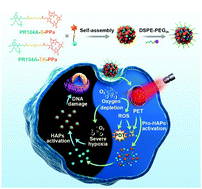Light-triggered dual-modality drug release of self-assembled prodrug-nanoparticles for synergistic photodynamic and hypoxia-activated therapy†
Abstract
Photodynamic therapy (PDT) leads to tumor hypoxia which could be utilized for the activation of hypoxia-activated prodrugs (HAPs). However, conventional photosensitizer-loaded nanoformulations suffer from an aggregation-caused quenching (ACQ) effect, which limits the efficiency of PDT and synergistic therapy. Herein, prodrug-nanoparticles (NPs) are prepared by the self-assembly of heterodimeric prodrugs composed of pyropheophorbide a (PPa), hypoxia-activated prodrug PR104A, and a thioether or thioketal linkage. In addition, a novel dual-modality drug release pattern is proposed on the basis of the structural states of prodrug-NPs. Under light irradiation, PR104A is released via photoinduced electron transfer (PET) due to the aggregation state of prodrugs. With the disassembly of prodrug-NPs, the ACQ effect is relieved, and PPa produces singlet oxygen which further promotes the reactive oxygen species (ROS)-sensitive release of PR104A. Such prodrug-NPs turn the disadvantage of the ACQ effect to facilitate drug release, demonstrating high-efficiency synergy in combination with PDT and hypoxia-activated therapy.



 Please wait while we load your content...
Please wait while we load your content...